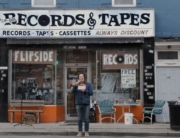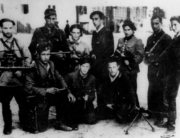The Settlers won’t answer every question about those whom news stories claim are a major roadblock to negotiations between Israelis and Palestinians. However, this Israeli documentary goes a long way toward bringing together perspectives that have been scattered through other films, particularly interviews with a new generation of determined fanatics who haven’t previously been seen by general audiences.
Nomenclature is fraught ever since the Israeli Army crossed into land that the Kingdom of Jordan claimed (as seen in Six Days June 1967: The War That Changed the Middle East) and has continued to hold since. What to call the area at the heart of the film defines a political position. Is it “Occupied Territories,” the West Bank of the Palestine State, the Biblical terms of Judea and Samaria, or the Kingdom of Judah? Very good maps and charts in the film mark this geography and the growing physical impact of the settlements over time: By 1982, 21,000 Jewish Israelis were living in 73 settlements; by 2015, at least 200,000 in more than 200 settlements and illegal outposts. (East Jerusalem doesn’t appear to be included in the film.)
Shimon Dotan made The Settlers more for the Israeli audience, so some differentiation among the settlers will not always be clear to Americans. (It has not been updated since screening at the New York Film Festival last fall.) Dotan basically follows the chronological order of groups laying claim to these areas since 1967 by interviewing those involved—with each one seeming more fanatical than the last, particularly the women.
How Sarah Nachshon and her family staged one of the first incursions, by subterfuge in 1968, was previously detailed in Giulia Amati and Stephen Natanson’s This Is My Land… Hebron (2010), and she emotionally repeats how she insisted on burying her infant (who died of natural causes) in the city, guarded by Israeli soldiers, because a Jewish cemetery created a permanent presence.
Elderly patriarchs of the settlement movement, with big bushy beards, are as implacable and hard to differentiate personally or philosophically. These interviewees have the look of the kinds of extremists Americans most identify with the settler movement, and who were also seen in Adam Hootnick’s Unsettled (2008), which captured the difficulty of removing them from Gaza in 2005.
Joseph Dorman and Oren Rudavsky’s Colliding Dreams (2015) provides the historical background to the changes in settlers’ attitudes over the years, represented in The Settlers by the defiant Daniela Weiss, now known as “the grandmother of the Hilltop Youth.” Additionally, Dotan was the first to gain access to the more radical younger generation, rebels who grew up in settlements and are now camping out and celebrating their freedom from adult supervision in illegal outposts. They use even more extreme language and endorse apocalyptic-sounding goals. (Their political party affiliations weren’t clear to an American audience, let alone if they are old enough or registered to vote).
It also isn’t clear if these youth are exempt from the army, what with the impact of settlers in the military, first seen for a wider audience in Joseph Cedar’s debut Time of Favor (2000), which warned through fiction of their danger as a fifth column in the Israel Defense Forces. Yaniv Magal’s new book The Story of Religious Zionists’ Army Integration points out the role of the army as a police force for the settlers against the Palestinians, enforcing their agricultural and water encroachments, which have aggravated tensions.
In addition to filming leading Israeli and Palestinian observers of the settlement movement, Dotan usefully includes other idealists—those representing hippie types and Christian evangelicals. There is also a very brief interview with a secular Israeli who lives in the disputed area only to have a nice house. This is what I have heard over the years from “the silent majority” of settlers (especially from the former Soviet Union), who are average Israelis who took advantage of the generous incentives to get a cheaper, more spacious home.
I was looking forward to seeing this documentary as a guide to where on the various political and religious spectrums on the West Bank my extended cousins reside, as I only recently figured out from their addresses and the photographs on their Facebook posts that they live in the West Bank. But, unfortunately, this didn’t help me enough.
Like the former Israeli military intelligence leaders who warned about the continuing occupation in Dror Moreh’s The Gatekeepers (2012), Dotan warns about the settlers: “There may be fewer than half a million of them, but they hold the fate of Israel in their hands, and by extension, the fate of the entire Middle East.”







Leave A Comment